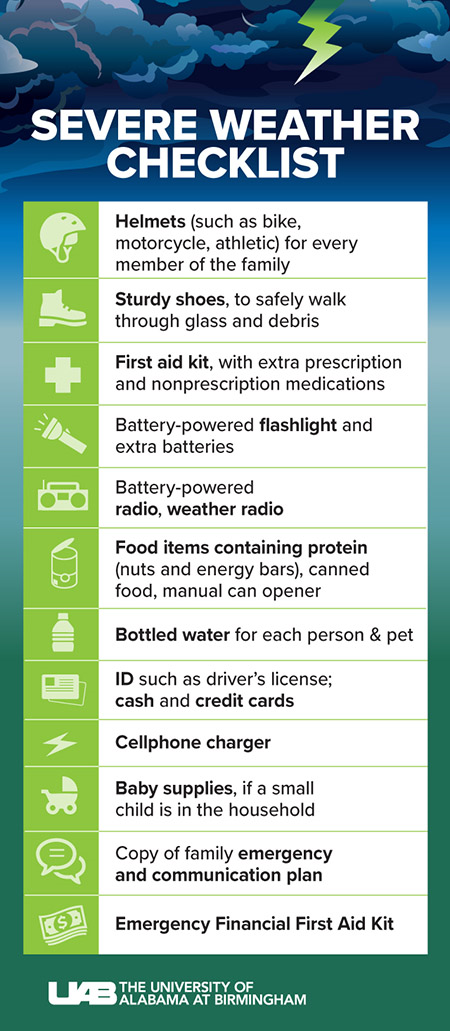Tyler Greer
UAB News
The physical, emotional and financial toll severe weather can inflict is overwhelming. The South, Midwest and even some Western states often experience tornadoes. Devastating floods and lightning deaths can happen almost anywhere in the United States.
March is the traditional beginning of severe weather season in the South, and Gov. Kay Ivey has declared Feb. 17-22 as Severe Weather Awareness Week in Alabama.
The National Weather Service and experts at the University of Alabama at Birmingham want everyone to use this week as an opportunity to review or create their severe weather plans, alter them if needed and properly plan for the coming season.
“This is the perfect time to make sure you have all of the items on your severe weather checklist on hand and in working order,” said Randy Pewitt, executive director of Emergency Management at UAB, a National Weather Service-recognized StormReady university. “Preparation now will make a tremendous difference later. It’s not a matter of whether or not we will have severe weather. It’s going to happen. Let’s be as prepared as we can be.”
Ways to prepare
April is the most likely month for major tornadoes in the United States, according to www.ustornadoes.com, and Alabama is at the head of the pack in deaths due to April twisters. The massive 2011 tornado outbreak alone claimed 248 fatalities in Alabama and 363 across the southern and eastern United States. It prompted many states, counties, municipalities — and individuals — to take a fresh look at their disaster preparedness plans and think of ways to communicate how to best be ready for severe, tornadic weather.
One of the ways Alabamians can prep for the upcoming season is to take advantage of the state’s sales tax holiday, held Feb. 22-24 this year.
“The sales tax holiday is a great opportunity to purchase any items you may be missing from your emergency kit,” Pewitt said.
Batteries, cellphone chargers, NOAA weather radios, duct tape, smoke detectors and fire extinguishers are some of the items exempt from taxes during the holiday. Find a complete list of tax-exempt items here, and find out if your city or town is participating here.
When the warning sounds
What are some other items you should have ready during severe weather season — especially when you know the threat of tornadoes exists?
In 2012, scientists in the UAB Injury Control Research Center published a research-driven commentary suggesting that helmets — bicycle, motorcycle, baseball, football or other athletic helmets — may prevent injury or death in severe weather situations and should be an essential addition to tornado-safety preparations.
See how a helmet possibly saved the life of an 8-year-old during the 2011 tornado outbreak.
Emergency management professionals now routinely recommend that every member of a family have a helmet and wear it during a tornado emergency.
Other recommended items emergency officials recommend include:
- Sturdy shoes for safely walking through glass and debris
- First aid kit with extra prescription and nonprescription medications
- Bottled water for each person and pet
- Canned or perishable food items containing protein (nuts and energy bars) and a manual can opener
- Driver’s license, cash and credit cards
- Cellphone charger
- Baby supplies (if necessary)
- Copy of family emergency and communication plan
- FEMA Emergency Financial First Aid Kit
- Any other essential personal items
A little preparation and some thought about the items needed for your home’s safe space can go a long way toward keeping your family safe during a storm.
Apps to consider
The National Weather Service and meteorologists recommend everyone have multiple ways to receive weather alerts.
A weather radio is an essential tool for life-threatening notifications. “This could save your family’s life in the middle of the night,” Pewitt said. The best type of radio to get is one that features Specific Area Message Encoding technology. A SAME weather radio will receive all NOAA and Emergency Alert System broadcasts. SAME technology also enables the user to receive information only for specific counties, rather than for an entire regional broadcast area.
A solar house built by UAB students has a central room that will withstand 250 mph winds.
Popular apps include the Big Sky skill for Alexa and iOS devices, Weather Radio by WDT, Radarscope, BeWeather 2, WeatherBug, Weather Underground, Hurricane by American Red Cross, and The Weather Channel.
Modes of severe weather
The National Weather Service will focus on four modes of severe weather next week — severe thunderstorms, flooding and flash flooding, tornadoes, and lightning — and emphasize the need to have multiple ways to receive alerts.
Everyone in Alabama is encouraged to conduct their own tornado safety drill Wednesday, Feb. 20. NOAA’s all-hazards radio test will run at a special time of 9 a.m. Feb. 20.
“This is an excellent opportunity for schools, civic organizations and businesses to practice what they would do in the event of a tornado warning,” Pewitt said. “If a warning is issued, know where you should go. Go to the lowest floor and put as many walls as possible between you and the outside. Put on a bicycle or football helmet to help protect against blunt force trauma to the head.”




